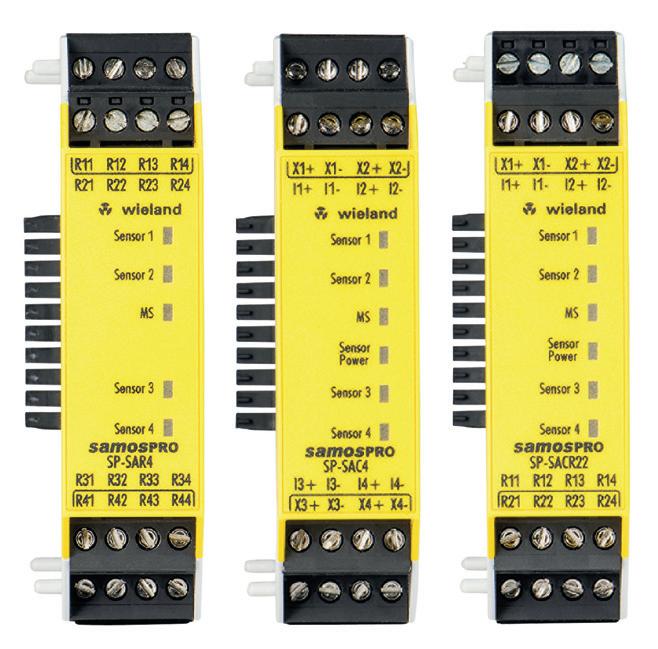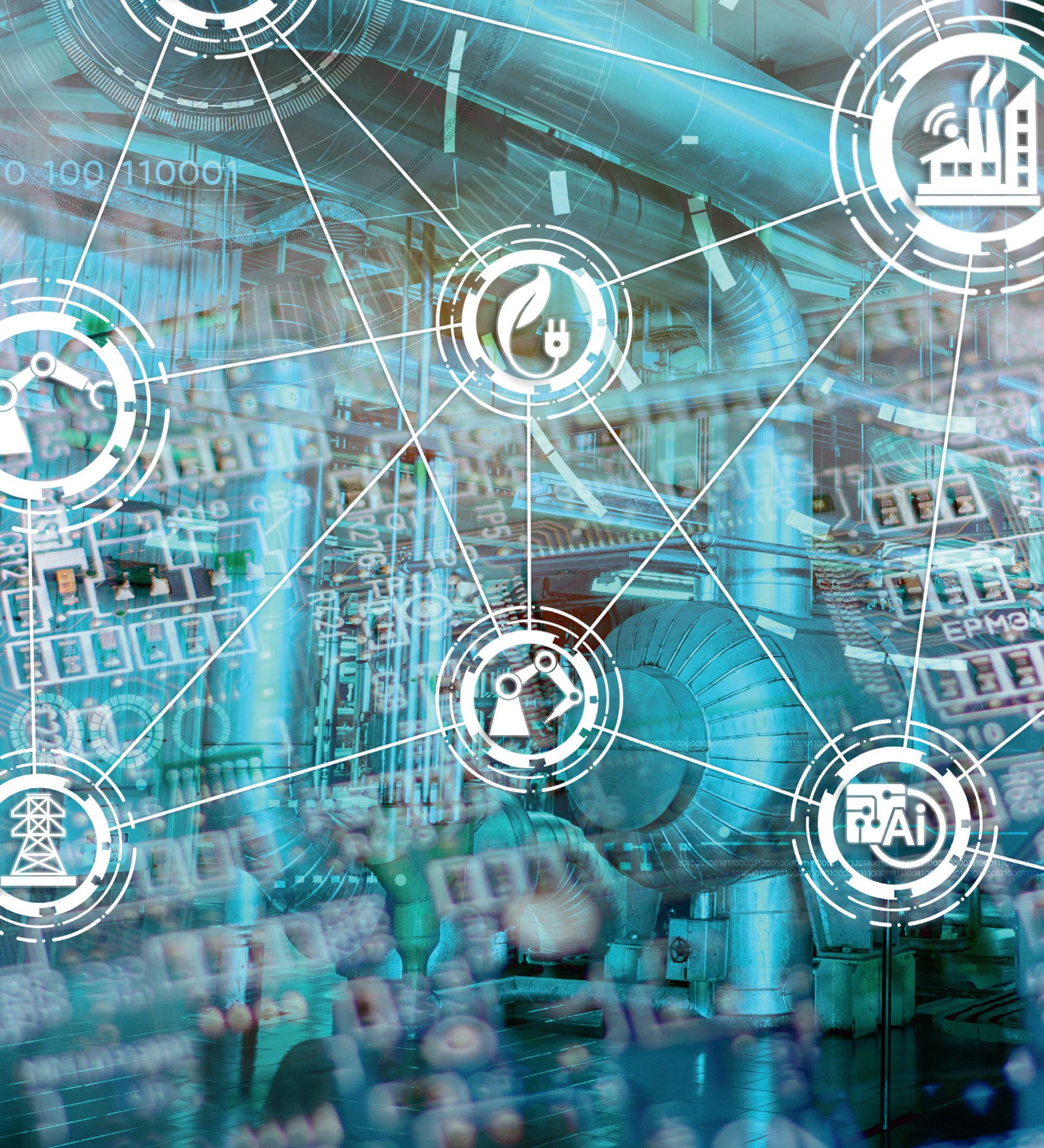
19 minute read
Digital transformation or just control system tuning?
DIGITAL TRANSFORMATION OR JUST CONTROL SYSTEM TUNING? ADDRESSING DIGITAL TRANSFORMATION HYPE David Walker*
AI will have an important role in improving process performance; however, the first steps should be to appraise the capabilities of existing technology. There is no doubt that AI has the potential to transform the process and manufacturing industries. AI and related technologies such as IoT, edge computing and cloud-based data platforms have created performance and optimisation opportunities that would have been unimaginable just a few short years ago. Condition monitoring, operations management, process optimisation and fault analysis are just some of the potential uses for AI, a field which is still evolving and yet to reveal its full potential.
What has unfortunately been missed by new technology entrants spruiking AI is that many solutions to typical process problems have always been available through existing control system technologies. What is now wrapped up in the language of AI and presented as new and innovative solutions are often just solutions that have the means to be addressed through the technology already present onsite. In many cases being approached using AI tools that are not always appropriate for the problem – delivered by companies that do not fully understand process and manufacturing – has the potential to add a degree of confusion, which often does not solve the problem and in fact can lead you further from the source of the problem.
While not looking to discredit the potential of AI, if used in ways which are not complementary to existing technology it runs the risk of having a costly and negative outcome, which can make people disillusioned and mistrustful of the new technology, blinding them to the real benefits available when it is used appropriately.

What is AI? So how do we decide what is appropriate use of existing or new technologies? First of all, it is important to understand what AI is. Artificial Intelligence is a set of technologies that enable computers to turn data into information and make decisions. At its core are a set of machine learning tools that find patterns in data and create models from these patterns. These tools include curve fitting of historical data (known as regression analysis) and statistical analysis.
This certainly has many useful applications, provided there is sufficient understanding of how these tools work and can be applied. Because they are trying to predict the future based on the past, without knowing anything about the processes they are modelling, they are likely to fail in the case of an unexpected event. Anyone who has monitored trends in the share market will understand how history is a poor indicator of the future. For example, if we create a model around the output size distribution of a ball mill based on input rock size, hardness and ball mill speed, then it can predict accurately up to the point other parameters not included in the model change, such as ball size. Once unexpected variability is introduced, the models developed can lose their potential impact.
What can be done with existing technologies? Mathematical modelling is an extremely powerful tool that has been around for decades. Unlike AI, it does not simply look at the past to predict the future. Rather, the model is developed to simulate the actual process. Such models, when properly implemented, will accurately predict an output based on any kind of event. For example, a mathematical model of a ball mill will predict product size distribution for any kind of input event.
Advanced process control (APC) using multivariable control algorithms (MVC) has been used successfully across a range of industries over many years to provide tight control in highly interactive processes. APC is well established in other industries but its potential has been little understood in the mining industry. However, it has been shown to be highly effective in grinding circuit controls, providing considerable benefits in production and quality.
Other tools, such as mass and energy balancing and mathematical modelling have been around for many years and are not AI. Yet increasingly these tools are presented as new and innovative AI-based solutions. There are numerous examples of technology businesses that are new to the sector promoting virtual flow or level meters as AI. These are simple mass balance algorithms that can be easily implemented in existing site control systems, without the excess cost, complexity and potential for misdirection that can arise from not understanding the process or existing technologies.
There is a wide range of tools available using existing technologies to solve process problems. What is now called an ‘edge device’ is just a renaming of existing technology. Field control devices have been around for decades and are capable of performing the complex functionality claimed by edge devices. But the introduction of this term has opened up the control environment to the IT world, and this has its own problems. Whereas control systems companies have had many years of experience in developing robust devices that operate reliably in extreme industrial environments, using software platforms that are bullet-proof, IT-based companies are introducing edge devices that are not designed for the rigours of industrial processes and the reliability expectations of industrial customers.
There are applications for some of these new devices, but once again their use needs balancing against process requirements, ap
APART FROM THE COST OF UNNECESSARY DEPLOYMENT,
INAPPROPRIATELY IMPLEMENTED AI SOLUTIONS CAN FALL
SHORT OF EXPECTATIONS, MEANING THAT PEOPLE ARE
LESS LIKELY TO SEEK OUT AI TECHNOLOGIES WHEN THEY
WOULD BE THE RIGHT CHOICE. implemented AI solutions can fall short of expectations, meaning
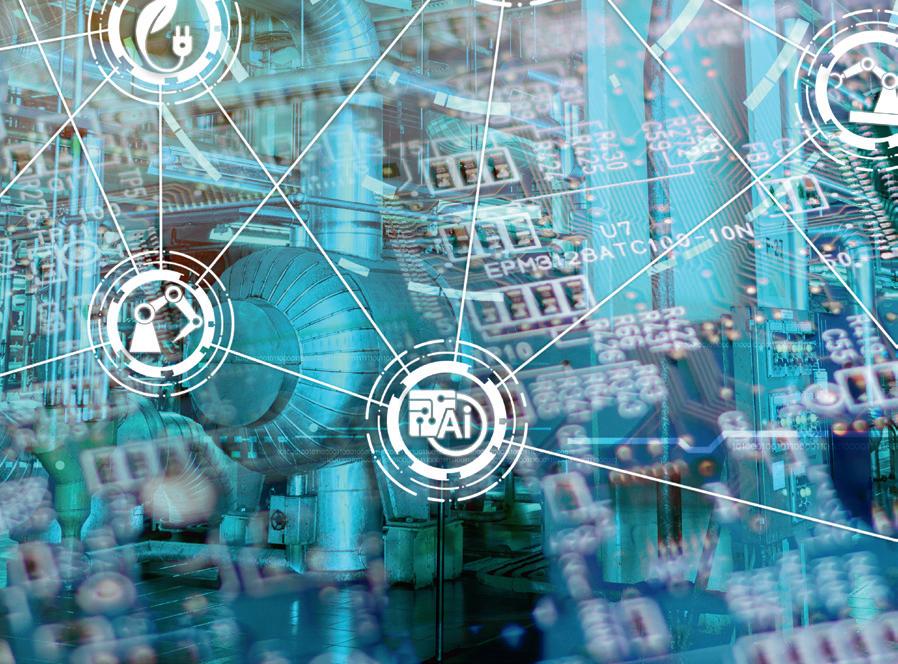
plicability and whether they bring anything truly new and innovative to the mix. With existing field devices, it is possible to perform complex control and analytical functions — for example, real-time analysis of the noise in a pressure signal to detect pump cavitation. This is proven technology that adds the desired performance analysis and improvement, on a platform which is likely already resident on your site.
Where does AI fit into the picture? New terms such as ‘digital twin’ are often used to refer to process models. But although the term is new, the technology is well established. So if these tools have always been available, why are there still problems to be solved, and what role does AI play?
Firstly, creating a mathematical model of a process or a piece of equipment, such as a ball mill, is more easily said than done. Fully understanding the physics of the ball mill is required to generate a useful model. But this is not easy to achieve. In cases such as these, building models using machine learning can provide a relatively simple way of building a useful representation that can be deployed quickly. These machine learning algorithms can be continuously evolving, reading data from the process and comparing it to the model. In this way, models can become quite accurate and informative over time.
Another example where AI can provide significant value is where there are networks of dependent processes, such as flotation cells and grinding circuits. Modelling these networks can be difficult to achieve, and AI can perform a valuable role in creating predictive representations of the process. One significant advantage of AI is that models can be created even when not all parameters are known or available. This is particularly valuable with processes such as flotation where critical parameters cannot be measured or inferred. In this case, building statistical models based on a large amount of accumulated data can assist in predicting production of the network of cells.
One of the challenges of introducing AI into a process environment is that of IT/OT convergence. This convergence is a result of the need to exchange data in real time between the process and analytics systems that are often cloud based. This introduces a range of issues around system availability and security, and requires a set of skills that are shared between IT and OT. Therefore, the need for these teams to work together is now a necessity, and requires organisational changes within businesses. IT/OT converAs Chief Engineer for Yokogawa Australia, he provides technology
gence also provides opportunities for tighter integration between control and IT systems, enabling seamless integration between process and business information.
Conclusion AI has an important role to play in improving process performance and Yokogawa are investing heavily in this space with solutions already on the market. However, when starting the journey of steps should be to appraise existing technology. Technology already available onsite can provide solutions to typical process problems, designed specifically for the process, without the cost and having to rely on complex black-box analytics. Solutions are often already residing on the plant, with process engineers who understand the technology, just waiting for someone to implement them.
Apart from the cost of unnecessary deployment, inappropriately that people are less likely to seek out AI technologies when they would be the right choice. There are many such instances where poor understanding and deployment of new technologies — such as fieldbus and wireless — have caused negative press around highly advantageous new methods for improving processes.
When considering solutions to a problem, the first question you need to ask is: are the physical principles of the process understood? Can information be inferred from other data? If so, generally speaking, the problem can be resolved with a simple algorithm in an existing system. If not, AI may be the best option, and this may open up new possibilities for your process. Before embarking on such a project, it is always worth talking to a range of vendors and engineers with expertise in the area to determine this best approach. This has always been the case, but even more so with the range of complex technologies available on the market.
In summary, when embarking on this journey, these steps will help to ensure that you choose the right technologies for the problem: • Clearly define the nature of the problem. Is it a physical problem, such as difficulties in measuring an important parameter? Is it a control problem where process stability is difficult to achieve? • Talk to the process engineers about the principals of the process.
Are they understood? Can they be modelled? • Consider the existing technologies available onsite. Talk to your
OT people and the technology vendors about how the systems can be used to solve the problem. • If exitsing systems cannot be used as a solution, consider an
AI solution. This will involve site OT engineers, corporate IT and IT/OT specialists who understand the overall requirements, including the logistics of connecting the control system to the corporate network and the cloud. • Consult with the control system vendor who has the OT/IT capability to facilitate the implementation and assist with site collaboration to achieve the best solution.
*David Walker is a chemical engineer with over 30 years’ experience in control systems across a wide range of technologies and industries, including oil and gas, mining, power, water and waste and chemicals. technology evaluation to resolve issues with AI in mind, the first
support, project execution management, engineering improvements and standardisation.
Using AI and an app to identify components
AI methods have long been successfully used in image processing with great success. Neural networks recognise everyday objects with greater accuracy than humans. Now researchers have developed an app that enables individual components with no barcode to be unambiguously identified within seconds. This application of neural networks will particularly benefit logistics companies, which can use them to speed up their incoming goods processes.
Companies are increasingly producing goods at different locations, working with multiple supply companies. There is no guarantee that all the components they receive are labelled with barcodes or type plates, which means that objects often need to be re-categorised in the receiving area. Employees then have to manually search the catalogue for similar parts to unambiguously identify them for further logistics processing — a painstaking and time-consuming task. Automated, digitalised recognition would be helpful to speed up the process. Researchers at Fraunhofer IPK in Berlin are applying machine learning methods The app interface. with what are known as convolutional neural networks (CNNs) to recognise manufactured components, such as screws, clamps, nozzles, pipes, tubes and cables, as well as microcontrollers and other electronics.
“CNNs have become the standard in image processing. Reliably recognising, say, 1000 everyday objects requires one million images for these networks to use as training data,” said Jan Lehr, a researcher at Fraunhofer IPK. “Our job was to generate an algorithm for industrial applications even with little data so that, in our case, components with no code can be recognised automatically, easing the burden on receiving staff.
“Our goal is to enable the algorithm to easily distinguish even highly similar objects from each other, such as screws of the same standard but different sizes or turbochargers from different production series.
“We use specially developed algorithms to limit the search radius to five or 10 objects, so employees no longer have to search through the entire range typically found in a large warehouse.”
To realise this, Lehr and his colleagues developed a detection system called Logic.Cube. The objects to be recognised, which have a maximum edge length of 40 cm, are placed in the cube-shaped device with an integrated scale and are photographed by up to nine cameras. An image processing algorithm measures the objects’ height, width and length in order to calculate what size box or shelf space is needed. At the same time, the resulting image set is stored in a database, together with the material number. This image data is used to train the AI algorithm to
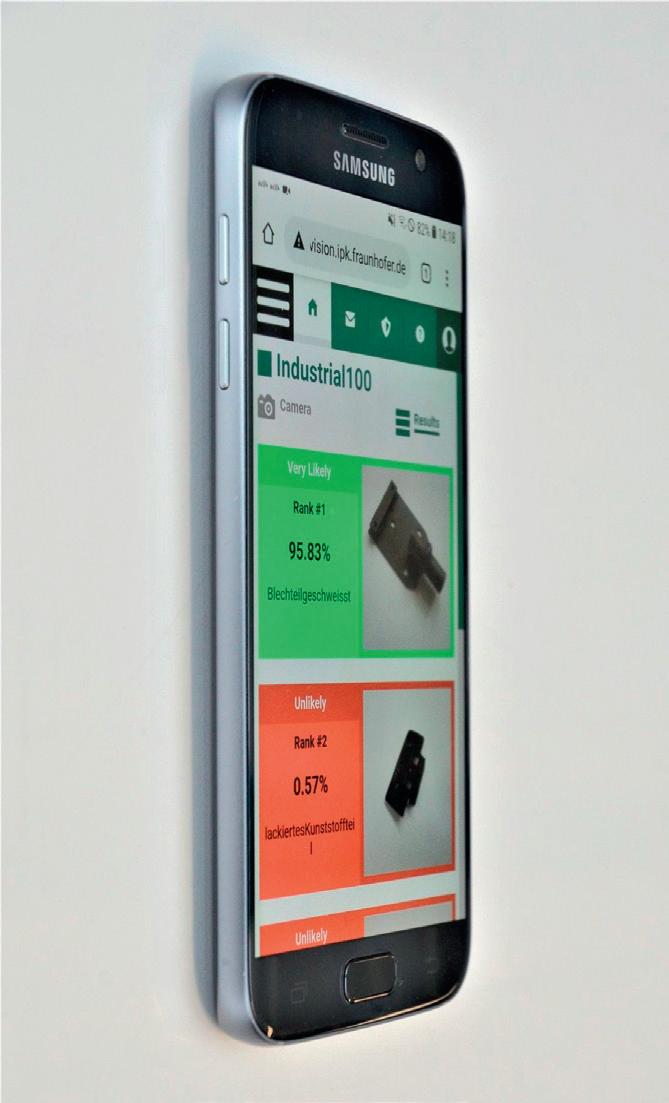
©Fraunhofer IPK.
enable it to recognise a wide array of different components. The Fraunhofer IPK research team has also ported the detection system’s functionality to a browser-based, operating system-independent app that works on smartphones, tablets, laptops and desktop computers. To do this, they had to expand the training dataset to include smartphone data and retrain the algorithm. “We tested the algorithms with a hundred components that had been photographed in a wide variety of scenes, with 50 images taken of each part. Within seconds, the app shows the user five or fewer potential matches, independent of lighting, background and scenery. The recognition is so robust that it can replace manual searching,” said the engineer. The researchers reached recognition rates of 98% in Logic.Cube and reduced the search radius from 4500 images to five. They aim to get the same success rate with the app. The images will be uploaded over the internet or the company’s intranet and stored in a local edge cloud, which is also where the actual image processing and recognition will take place.
“The AI algorithms run on the server and the smartphone or tablet app is the client,” Lehr explained. The system is designed in such a way that it continuously collects additional data, and after a time this new data can be used to retrain the algorithms, resulting in a continuously self-improving system.
Currently the researchers are working to expand the set of image data and to digitalise the catalogue and integrate it into the app. Lehr and his colleagues are also optimising the algorithms to enable recognition of even highly similar-looking objects. In the test runs they conducted, the system correctly recognised even screws of the same standard but different sizes.
The app can also be used for surface inspection. An AI-based image shows whether parts have any scratches or corrosion, or whether they were damaged during transport or are just a bit dirty. AI methods are used to mark the relevant spots on the image so workers can immediately check the damaged areas.
“Manufacturing companies are often still cautious when it comes to AI,” Lehr said. “We would be very pleased if our research work could help counter this scepticism and boost acceptance among employees.”
A longer and more detailed version of this story can be read online at: https://bit.ly/32WcnVT
SAFETY CONTROLLER/RELAY HYBRID
The Banner Engineering SC10 Series compact safety controller/relay hybrid is an easy-to-use safety controller for smaller machines that replaces the functionality of two or more safety relay modules. It features an intuitive user interface and advanced diagnostic capabilities.
In-Series Diagnostics (ISD) provides detailed status and performance data from each connected safety device, which can be accessed with a HMI or similar device, while intuitive, icon-based programming with drag-and-drop PC configuration simplifies device set-up and management.
The SC10 supports a wide range of safety devices, eliminating the need to buy and stock safety relay modules dedicated to specific safety devices. It provides two safety 6 A relay outputs each with three NO sets of contacts, and 10 inputs, including four that can be used as non-safe outputs. Industrial Ethernet twoway communication enables 256 virtual non-safe status outputs and 80 virtual non-safe inputs (reset, on/off, cancel off-delay and mute enable).
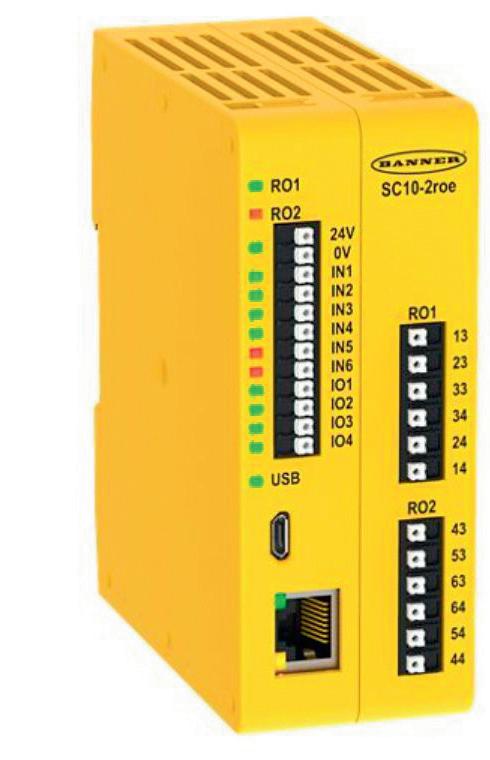
Turck Australia Pty Ltd
www.turck.com.au




RFID-CODED SOLENOID INTERLOCK
ATOM from Fortress Interlocks is a compact and robust RFIDcoded solenoid interlocking device. It is externally approved and is suitable for applications up to PLe (Cat. 4). The metal housing and high retention force makes ATOM suitable for heavier industry applications.
High misalignment in the self-centring actuator covers any movement and inaccuracy in hinged and sliding door machine guarding. Additionally, ATOM’s head has an open design manufactured in stainless steel to prevent dust, dirt and corrosion from impacting performance.
Available in multiple hardware variants, the device can be configured for applications where hazards persist after machinery is powered off. Multiple units can also be connected together with OSSD (output signal switching device) functionality preventing fault masking. The large LED lens at the base provides clear state indication from all angles and at a distance.
Fortress Systems Pty Ltd
www.fortressinterlocks.com







INDUCTIVE SAFETY SENSORS
Pepperl+Fuchs inductive safety sensors come with SIL 2 functional safety and PL d Machinery Directive approvals. With redundant implementation SIL 3/PL e can be achieved. High characteristic safety values enable easy integration into the safety loop and prolong operating intervals.
With intelligent electronics, the sensors do not have a dead band. This means that no minimum distance needs to be maintained between the sensor and the target. Simple standard metal targets can be used for detection; no special coding is required. A standardised OSSD interface and comprehensive safety documentation ensure quick and easy integration of the safety sensors.
The range includes four models with different designs (cylindrical, rectangular) and switching distances, creating a wide range of application possibilities. The rugged cylindrical versions feature an extended temperature range from -40 to +85°C and an E1 approval, making them suitable for mobile equipment applications.

Pepperl+Fuchs (Aust) Pty Ltd
www.pepperl-fuchs.com

LIGHT GRID WITH INTEGRATED MUTING UNIT
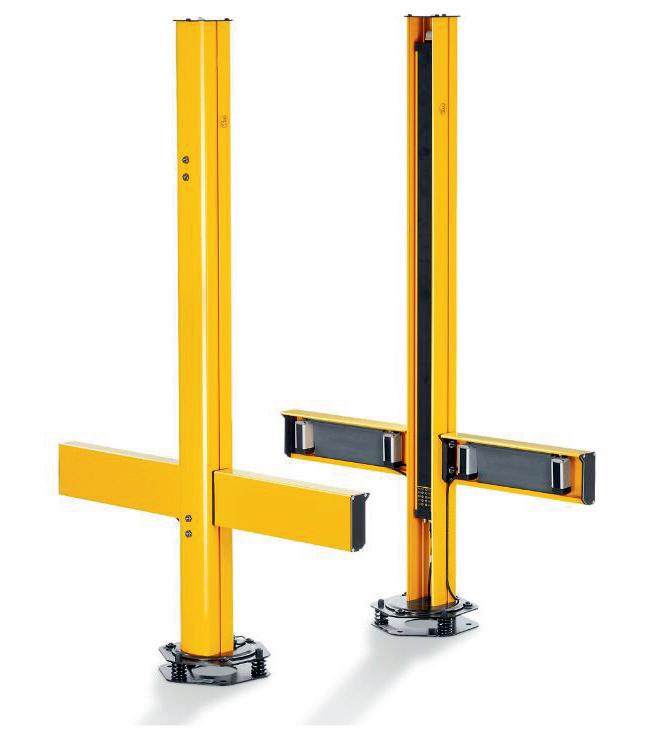
The latest generation of light grids from ifm allows for a muting mode without an external junction box or a muting relay being required, as they are already integrated into the receiving element.
The supported muting versions are available as either crossbeam or parallel muting. Both versions allow transported material to be safely passed in or out via the protected area. A status light, integrated into the receiver, allows for indication of the operating status.
The muting arms can be directly installed on the light grid and are available in two versions: either as muting arms with multibeam sensors, similar to a miniature light grid, or as premounted mounting set with single-beam sensors. No complex installation and adjustments are necessary.
ifm efector pty ltd
www.ifm.com/au

TRANSPONDER-CODED GUARD LOCK
The Euchner CTM transponder-coded guard lock provides process and personnel protection in small spaces, making it suitable for securing small doors and flaps. At 120 x 36 x 25 mm in size, the switch is easy to integrate into packaging machines. Typical applications include case packers and dosing, filling and sealing machines. The ball actuator supported on an elastomer bearing can also secure doors with extremely small pivoting radii.
With an IP69 degree of protection, the switch’s special hygienic version makes it particularly suitable for the food and pharmaceutical industries. The CTM provides Cat. 4/PL e safety door protection according to EN ISO 13849. Due to its different product variants and interfaces, the switch offers a solution for many applications and is well suited to Industry 4.0 applications because of its IoT-compatible communication via IO-Link.
Treotham Automation Pty Ltd
www.treotham.com.au

SAFETY CONTROLLER ANALOG MODULES
Wieland Electric has extended its samos PRO COMPACT safety controller range to include analog input modules. With the SP-SAC, SP-SAR4 and SP-SACR22, it is now possible to detect and further process analog signals for the purposes of safety control. These modules are suitable for use in process engineering applications in the glass, metal or chemical industry or also in specific areas of manufacturing such as conveyor systems, presses and CNC machines.
The modules support sensors with a 0/4–20 mA interface as well as temperature-dependent resistors like Pt/Ni sensors and deliver their analog data to the samos PRO COMPACT safety controller. The analog values can be monitored with ‘Limit’, ‘Range’, ‘Relation’ and ‘Difference’ function blocks in user programs created with the samos PLAN 6 software. These function blocks enable comparative or arithmetic operations involving analog data as well as scaling of the measured current values, and the presentation and visualisation of the analog values in samos PLAN 6.
Integrated USB and Ethernet interfaces enable access to the system, and industrial Ethernet protocols have been included. Further additional gateways for fieldbuses make integration into industrial networks possible. Up to three fieldbus systems can be operated from one samos PRO COMPACT in parallel.
For safe operation of the system, all inputs and outputs have uniquely assigned visual displays that clearly show the operating status at any time. The modules meet all safety standards, including SIL CL 3 according to EN 62061 and PL e/category 4 according to EN ISO 13849-1.

DKSH Australia Pty Ltd
www.dksh.com.au
